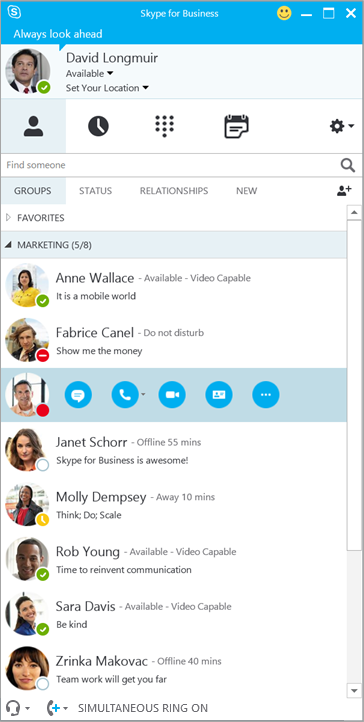Skype for Business (Now Microsoft Teams) is here - what's next?
Are you looking for information on Upgrading Skype to Microsoft TeamsnewsupgradingskypebusinessmicrosoftteamsLast week we announced...

Are you looking for information on Upgrading Skype to Microsoft Teams?
Last week we announced the release of the new Skype for Business. Today, I’m excited to share with you some of the upcoming new features that Microsoft will be rolling out in Skype for Business this summer.
Enabling people to connect with one another is central to Microsoft’s mission to reinvent productivity and help people make the most of every moment. For us, connecting people means delivering experiences capable of conveying all forms of human expression—verbal, written, visual and emotional. In today’s modern workplace, productivity will increasingly be centered on conversations, whether in writing, in person, via phone or video conference call. People need communications tools that allow them to express themselves in the most natural and approachable way possible, and that work the way they do—fluidly across locations and devices.
Together with their customers and partners, Microsoft has transformed enterprise communications. Over 100 million people now use Microsoft Lync to communicate for work, with 79 percent of U.S. enterprises currently using or planning to deploy Lync for telephony. With Skype, Microsoft is the preferred choice for consumer communications too. Skype revolutionized the way people connect with friends and family. Today, Skype sees 50 billion minutes of traffic every month—one third of the world’s long distance traffic—and over 50 percent of Skype users now come in over video.
And now, it’s all come together—the familiar experience of Skype that people have come know and love, with the trusted platform in Lync that businesses around the world count on. Microsoft first announced in November that the next version of Lync would become Skype for Business, and last week the Skype for Business client, Skype for Business Server, and the new service in Office 365 began rolling out.
What’s next in Skype for Business?
The Skype for Business Team at Microsoft reveals all…
A familiar experience that IT will love too
The journey starts with Skype for Business, which brings together the much loved Skype interface, with an expanded Lync feature set that continues to deliver enterprise-grade performance, security, compliance and control. Everyone knows how to use Skype, so in the workplace, it’s intuitive right from the start. This familiarity, combined with the ability to video call anyone who has a Skype ID, make Skype for Business a powerful communication tool that has the ability to transform the way people work. And because it’s part of Office 365, Skype for Business features like presence, IM, voice and video calls, and online meetings are integrated with the productivity tools people use every day, like email, calendaring and document collaboration. Skype for Business will combine innovation from client to cloud, while also connecting businesses to the world’s largest video network.

The right cloud for communication and productivity
The next step is the investments we are making over the next year to enhance our cloud for real-time communications. Office 365 is the world’s cloud for productivity, and Microsoft is the only vendor with a cloud designed for modern business, with communications at the heart of the Office 365 productivity solution. As part of the Office 365 platform, Skype for Business will deliver at massive worldwide scale, with datacenters in 37 countries; with the most comprehensive productivity experience; and enterprise-grade reliability and controls on top of a secure and compliance-ready platform. That’s why over half of Microsoft enterprise customers are already using Microsoft cloud services.
Building on this foundation, I’m happy to announce we will deliver three new services in Skype for Business. We will offer enterprise voice and audio conferencing in Office 365, starting with a technical preview in the U.S. this summer, as well as enterprise-grade PSTN connectivity, beginning in the U.S. later this year, followed by a global roll out. This means Office 365 can be used for all your conversations—written, audio and video. The Office 365 Skype for Business voice and video services are based on an intelligent real time network, spanning Microsoft’s global datacenters, to deliver secure, high quality voice and video traffic at the speed of light across the globe. Our strategic partners AT&T, BT, Colt, Equinix, Level 3 Communications, Orange Business Services, TATA Communications, Telstra, Verizon and Vodafone, will deliver direct connections to Office 365 Skype for Business customers through Azure ExpressRoute for Office 365. These investments will benefit our on-premises customers as well as those using our cloud. We are enabling cloud plus on-premises hybrid options so that you can rely on our cloud when you need it without having to give up what you want to manage on-premises.
Modern meetings The third step is to deliver a rich portfolio of meetings devices intentionally designed for and integrated with Skype for Business. I’m pleased to announce Skype Room Systems, which will deliver the Skype for Business experience to the more than 50 million meeting spaces of all shapes and sizes in use by organizations worldwide. Together with our partners, Crestron, Polycom and Smart, we will bring the world’s physical meeting spaces into the next era of communications experiences with a range of devices optimized for Skype for Business. Skype Room Systems devices will be built on a platform based on Windows 10, and will be available for customers in the Windows 10 timeframe. Since Skype Room Systems devices are the next evolution of Lync Room Systems, all Lync Rooms Systems devices will also be upgradable to Skype Room Systems and the Skype for Business experience.
Today we also announced an expanded relationship between Microsoft and Polycom through which Polycom will deliver a new series of solutions called Polycom RoundTable, purpose-built for Skype for Business. The first new device in this new offering is the Polycom RoundTable 100. Designed for small-to-midsized businesses (SMB) and teams, and expected to be offered at a price point of around $1,000. RoundTable 100 is an incredibly simple, yet powerful, device that requires no IT assistance and provides customers the opportunity to experience Skype for Business in small meeting spaces. Additionally, the video devices in the Polycom CX series of products—the CX5100, CX5500 and CX8000—will also become part of the Polycom RoundTable series of products. Together, this series of products serve as another important step in delivering the Skype for Business experience to meeting rooms across businesses of all sizes. In addition, Polycom’s VVX business media phones will be the first phones to support PSTN calling in Office 365.
Also designed specifically to take full advantage of Skype for Business, the Microsoft Surface Hub is a new large-screen device built for ink and touch, and optimized for group collaboration. It delivers digital white boarding based on OneNote, the ability for multiple people to share and edit content to the screen from any device, and support for Windows 10 apps, all which help make meetings more engaging and productive.
Start the journey with us today
We’re harnessing the cloud and modern devices to deliver more natural, intuitive and intelligent communication experiences than have ever been possible before. Join us on this journey to the future by trying the new Skype for Business client, signing up to be part of the Skype for Business Cloud Voice Preview in the U.S. this summer, and connecting with a Microsoft partner to plan your deployment of Skype for Business. Learn more about how you can move your business forward with Skype for Business here.
Microsoft is on a mission to connect people everywhere so that they can achieve more together. We can’t wait for you to experience the power of Skype for Business and realize the potential of this new era in workplace communications.
This article by Zig Serafin originally appeared on the Office Blogs





